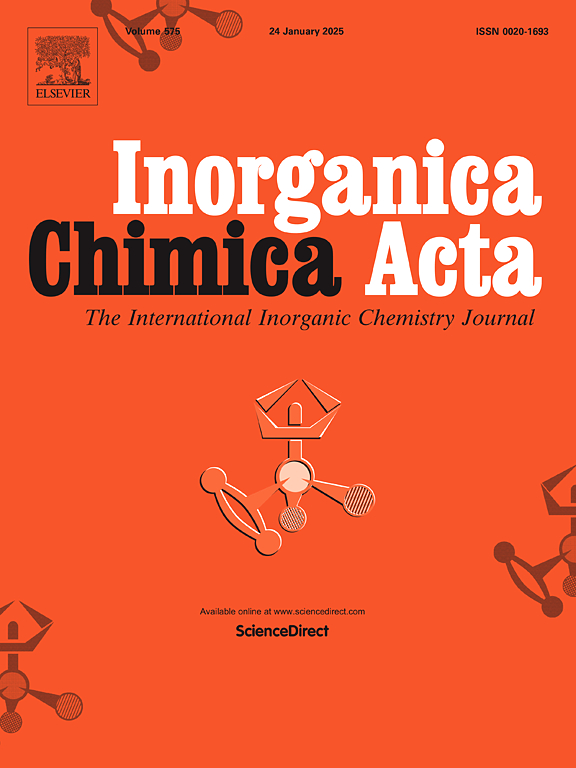新型铁有机框架锚定石墨棒电极的超灵敏噻虫嗪检测电化学传感平台
IF 3.2
3区 化学
Q2 CHEMISTRY, INORGANIC & NUCLEAR
引用次数: 0
摘要
新烟碱类农药在农业种子处理中使用较多,造成环境污染和食品污染。为此,需要开发高度可靠和有效的电分析平台,以获得价格合理、成本低、灵敏度高的传感器来测定新烟碱类分子。在这个实验中,我们的研究证明了使用铁金属有机框架(Fe-MOF)混合石墨棒进行噻虫嗪超灵敏检测的新型独立式电化学传感平台。采用单步快速溶剂热处理法制备了小麦种子状Fe/BPDCA@GRP/MOF。在Fe/BPDCA@GRP/MOF中,电极具有较大的外表面积、大量的孔隙和丰富的活性位点,增强了硫噻肟(TMX)的吸附机理。这种小麦种子状MOF杂化GRP电极对选定的分析物表现出优异的电化学传感性能和电催化活性。不同的表征技术被用来表征所开发的复合材料。电极的线性动态响应(LDR)范围为5 ~ 100 μM,检测下限为3.44 nM,电活性表面积为0.0054 cm2。该电极成功地应用于加标橙汁样品中噻虫嗪的测定,可接受的回收率为98.7% ~ 103.2%。因此,传感器电极为噻虫嗪检测提供了一种简单、经济、环保、便携的解决方案。本文章由计算机程序翻译,如有差异,请以英文原文为准。

An ultrasensitive electrochemical sensing platform for thiamethoxam detection using novel iron-organic framework anchored graphite rod electrode
Neonicotinoids are used more frequently in agricultural seed treatments, resulting in environmental pollution and food contamination. For this end, there is a need for the development of highly reliable and effective electroanalytical platforms in such a way that obtain affordable, low-cost, and highly sensitive sensors for the determination of neonicotinoid molecules. In this experiment, our investigation testifies and characterizes the novel free-standing electrochemical sensing platform for ultrasensitive detection of thiamethoxam using an iron metal organic framework (Fe-MOF) hybrid graphite rod. Wheat-seed-like Fe/BPDCA@GRP/MOF was developed via single-step facile solvothermal treatment. In Fe/BPDCA@GRP/MOF electrode provides a large exterior area, an enormous number of pores and an abundance of active sites, which enhance absorption mechanism of thiamethoxam (TMX). This wheat-seed-like MOF hybrid GRP electrode showed superior electrochemical sensing properties and excellent electrocatalytic activity against selected analytes. Different characterization techniques were used to characterize this composite that had been developed. As-proposed electrode exhibited a lined dynamic response (LDR) from 5 to 100 μM, with lower limit of detection (LOD) of 3.44 nM, and high electroactive surface area of 0.0054 cm2. Our projected electrode has successfully applied for the determination of thiamethoxam in spiked orange juice samples with acceptable recovery results varied from 98.7 % to 103.2 %. Hence, the sensor electrode offers a straightforward, budget-friendly, eco-conscious, portable, and economical solution for thiamethoxam detection.
求助全文
通过发布文献求助,成功后即可免费获取论文全文。
去求助
来源期刊

Inorganica Chimica Acta
化学-无机化学与核化学
CiteScore
6.00
自引率
3.60%
发文量
440
审稿时长
35 days
期刊介绍:
Inorganica Chimica Acta is an established international forum for all aspects of advanced Inorganic Chemistry. Original papers of high scientific level and interest are published in the form of Articles and Reviews.
Topics covered include:
• chemistry of the main group elements and the d- and f-block metals, including the synthesis, characterization and reactivity of coordination, organometallic, biomimetic, supramolecular coordination compounds, including associated computational studies;
• synthesis, physico-chemical properties, applications of molecule-based nano-scaled clusters and nanomaterials designed using the principles of coordination chemistry, as well as coordination polymers (CPs), metal-organic frameworks (MOFs), metal-organic polyhedra (MPOs);
• reaction mechanisms and physico-chemical investigations computational studies of metalloenzymes and their models;
• applications of inorganic compounds, metallodrugs and molecule-based materials.
Papers composed primarily of structural reports will typically not be considered for publication.
 求助内容:
求助内容: 应助结果提醒方式:
应助结果提醒方式:


